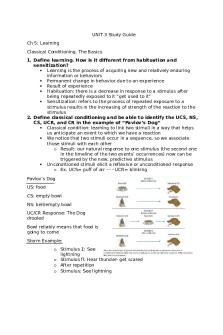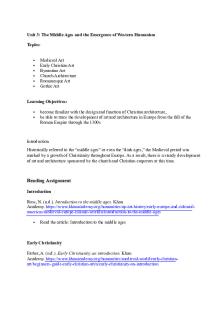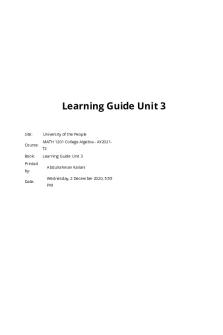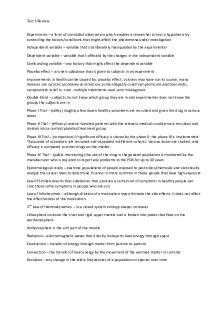Unit 3 study guide - unit test 3 PDF

| Title | Unit 3 study guide - unit test 3 |
|---|---|
| Author | Ella MacCallum |
| Course | Physical Geography |
| Institution | SUNY New Paltz |
| Pages | 3 |
| File Size | 53.7 KB |
| File Type | |
| Total Downloads | 78 |
| Total Views | 209 |
Summary
unit test 3...
Description
Part 1: Definitions ● Aquifer- a permeable subsurface rock layer that can store, transmit, and supply water ● Capillary Water- moisture held at the surface of soil particles by surface tension ● Gyre- arrangement of surface ocean currents into a large, macro-scale circular pattern of flow ● Hydrosphere- total water realm of earth, including the oceans, surface waters of the land, groundwater, and water held in the atmosphere ● Hygroscopic water- microscopically thin film of moisture that is bound rigidly to soil particles ● Ocean current- large-scale horizontal flow of water that is persistent and driven by atmospheric circulation ● Tides- the rise and fall of coastal water levels caused by the alternate increasing and and decreasing gravitational pull of the moon and sun or varying parts of earth’s surface ● Water table- the top of the saturated zone within the ground or the boundary between the zone of aeration and the zone of saturation ● Zone of aeration- the topmost hydrologic zone below the surface of the ground, which contains a fluctuation amount of moisture in the pore spaces of the soil ● Zone of saturation- the second hydrologic zone below the surface of the ground, whose uppermost boundary is the water table. The pore spaces and cracks in the bedrock of this zone are fully saturated with water
Part 2.A : Hydrosphere concepts ● What percentage of water cover the earth’s surface: 70% ● How does water help regulate climate - High specific heat→ thermal regulation of climate - Found in solid, liquid, and gas states ● What are the states of water and what makes them unique - Solid (ice) - Liquid (water) - Gas (water vapor) ● Proportion of freshwater to saltwater - Salt: 97.4% - Freshwater: 2.5% Part 2.B: Hydrologic Cycle ● Evaporation- change in state from a liquid to a gas - Sun’s energy warms surface water - Energy speeds up and the molecules move around faster - Turns into a gas - Moving water from liquid to gas ● Condensation- gas to liquid - Water is up in the atmosphere
●
●
●
● ●
●
- Cold enough that the water vapor returns to its liquid state Precipitation - Gravity takes hold of droplets - If the droplets go from tiny to big enough, they can drop to the ground in the form of precipitation - Can do things like cause erosion Interception- when precipitation hits plants or trees - Raindrops coming down - Either hits the leaves or falls through (through fall) - Raindrops hit a leaf, and work their way back to the trunk or a stem and to the roots (stem flow) - Water hits the tree, some will go out to the edges of the tree and drip right around the footprint of the canopy (canopy drip) Infiltration - Water going into the soil - Soil is kind of like a sponge - Eventually the water makes its way back into lakes, oceans, or the atmosphere due to flow underneath the ground Run Off - Water stays on the surface and runs along the surface Transpiration - Plant sweat - Some of the water that ends up in the soil and some of the water gets taken up by roots of the plant - Can sweat the excess moisture out through the plant cells As water moves, it’s transferring energy
Part 2.C- Soil water and Groundwater ● If the surface is at the top, right under the surface is the zone of aeration (unsaturated zone) ● Right under that is the zone of saturation ● Water table: the line of saturation that separates the zone of aeration and the zone of saturation - Moves up and down due to water levels ● Soil is not a solid mass, it’s made up of different particles ● There are spaces between all of these particles ● Zone of aeration has three different types of soil water - Gravitational water: water that moves into the soil relatively quickly due to gravity’s pull - Capillary water: water that’s sitting inside the pores between molecules - Hygroscopic water: thin membrane of water that surrounds a particle; so tightly bound to the particle that it’s impossible to remove it ● Seepage- lateral movement of water
● ● ● ●
Percolation- downward movement of water by the force of gravity Confined runoff- when runoff is confined to a kind of channel or stream Unconfined runoff- runoff that is not confined by anything and is just moving freely downward Depression storage- small low points in undulating terrain that can store precipitation that would become runoff
Part 2.D- Ocean concepts ● Oceans cover 70% of earth’s surface ● More ocean in the southern hemisphere than the northern hemisphere ● Water moves in multiple different ways - Currents move horizontally - Tides move vertically ● Currents: really big displacements of water ● Surface currents are driven by trade winds, which affect their motion ● Tides: vertical movements that are bulges of water - Caused by gravitational attraction from the moon and a little bit of the sun - Moon plays a bigger factor because it’s closer in its gravitational pull...
Similar Free PDFs

Unit 3 study guide - unit test 3
- 3 Pages

UNIT 3 Study Guide
- 19 Pages

Unit 3 Study Guide
- 4 Pages

ENG 214 Unit 3 Test Study Guide
- 7 Pages

Unit 3 Study Guide - notes
- 8 Pages

Student Study Guide Unit 3
- 13 Pages

Astronomy - Unit 3 Test - Unit 3
- 8 Pages

Unit 3 - Milestone 3 Test
- 3 Pages

Learning Guide Unit 3
- 20 Pages

Physics Unit 3 Test
- 4 Pages

Unit 3 Study Questions
- 12 Pages

Unit 2 Test Study Guide
- 5 Pages

Unit 3 homework - unit 3
- 4 Pages
Popular Institutions
- Tinajero National High School - Annex
- Politeknik Caltex Riau
- Yokohama City University
- SGT University
- University of Al-Qadisiyah
- Divine Word College of Vigan
- Techniek College Rotterdam
- Universidade de Santiago
- Universiti Teknologi MARA Cawangan Johor Kampus Pasir Gudang
- Poltekkes Kemenkes Yogyakarta
- Baguio City National High School
- Colegio san marcos
- preparatoria uno
- Centro de Bachillerato Tecnológico Industrial y de Servicios No. 107
- Dalian Maritime University
- Quang Trung Secondary School
- Colegio Tecnológico en Informática
- Corporación Regional de Educación Superior
- Grupo CEDVA
- Dar Al Uloom University
- Centro de Estudios Preuniversitarios de la Universidad Nacional de Ingeniería
- 上智大学
- Aakash International School, Nuna Majara
- San Felipe Neri Catholic School
- Kang Chiao International School - New Taipei City
- Misamis Occidental National High School
- Institución Educativa Escuela Normal Juan Ladrilleros
- Kolehiyo ng Pantukan
- Batanes State College
- Instituto Continental
- Sekolah Menengah Kejuruan Kesehatan Kaltara (Tarakan)
- Colegio de La Inmaculada Concepcion - Cebu


